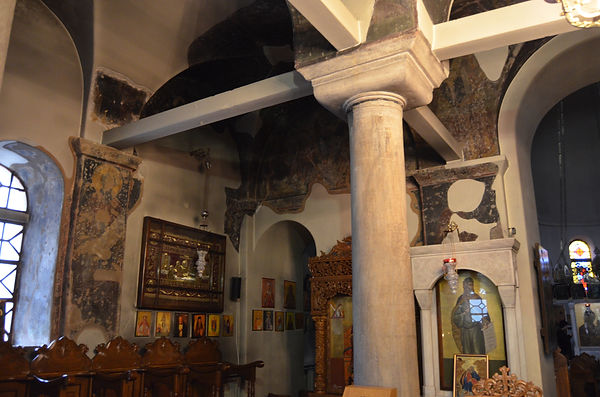In the labyrinthine streets of the Upper City of Thessaloniki, overlooking the lower city and its harbor is a Palaiologan church of imposing size. Now known as the Church of the Prophet Elijah (Profitis Elias), the identity of the church is problematic since its original name was forgotten during the almost five hundred years of subjugation to the Ottoman Turks that followed. It is one of the 15 Paleochristian and Byzantine Monuments of Thessaloniki that were included in the UNESCO World Heritage List in 1988.
The architectural type of the church, appropriate to the katholikon of a monastery, and its location in the area in which the Byzantine Palace that was burned during the Zealot uprising in 1342 is thought to have stood, have misled some scholars into identifying it with the Nea Moni. This monastery was founded between 1360 and 1370 by the monk and writer Makarios Choumnos, a scion of an old Thessaloniki family, one of the wealthiest in the empire in the 14th century. According to Byzantine sources, the Nea Moni was built at the finest point of the city, at a place where there had once been a palace. The monastery, which was dedicated to the Virgin, was one of the most important monastic foundations in the city in the second half of the 14th century, and its abbots included leading figures such as Gabriel, Metropolitan of Chalcedon and later of Thessaloniki.
The identification of the church of Profitis Elias with Nea Moni, which was widely accepted, has been shaken by the evidence of the Turkish sources. It has been suggested that the church of Profitis Elias should be identified rather with the Akapniou Monastery, an important foundation in Thessaloniki that was closely connected with the Palaiologan dynasty. The architectural type of Profitis Elias is unique in Thessaloniki. It is a tetrastyle cross-in-square church with side choruses, known as the Athonite type, since it was invented by Saint Athanasios the Athonite, the founder of the Great Lavra, about 1000. This type was used exclusively for the katholika of monasteries.
In the church of Profitis Elias, four small bays roofed with domes are added to the sides of the side apses, called choruses. The ones at the east, the typikatia, served as sacristies, and those at the west as chapels. The main area of the church is covered by a large dome, 5.50 m in diameter. To the west of the nave is the lite, a spacious narthex suitable for the services held in accordance with the monastery routine. The lite has four columns and is roofed with cross-vaults and two domes over the rooms in the north-west and south-west corners. A small staircase in the thickness of the wall of the lite leads to the upper floor, a narrow room over-looking the nave. The function of this room, which is called the katechoumenon, is frequently related to imperial services, and is therefore found in churches that were either imperial foundations or connected with members of the imperial family. The west and parts of the north and south sides of the church arc enclosed by an open ambulatory.
The church was built of courses of well-dressed blocks of white stone, alternating with two or three courses of bricks. This masonry system is very rare in Macedonia, but is the predominant form in Constantinople. The church also has very rich decorative brickwork, mainly on the east face. This very careful masonry, however, used mud as mortar, and lime plaster is used only for the exterior joints. The present form of the monument is the product of restoration work carried out in 1956-61, during which the ambulatory, the domes over the narthex, and the chapels at the west were reconstructed.
The painted decoration survives mainly in the lite, with fragments also in the nave and the chapels. Scenes are preserved of the childhood and Miracles of Christ, and some individual figures of saints. There were also wall-paintings in the apses of the exterior west side of the lite, as is clear from the depictions of Saint Anne and the Virgin, and the Virgin and Christ in two of them. The wall-paintings are usually dated to between 1360 and 1370, and have an impressive richness and unprecedented realism in some of the scenes and figures. In the view of some of the leading scholars of Byzantine art, they decisively influenced the later wall-paintings in some of the churches in the Morava region of Serbia.
Page under construction

Paul Jouve (1916)
.jpg)
Konstantinos Maleas (1914-1917)
Texier (1864)
Charles Martel (1917)
Pierre Machard (1917)
Pierre Machard (1917)
Lobel-Riche (1916)
René Prouho (1916)
Postcard before 1919
Aristotle University of Thessaloniki
Aristotle University of Thessaloniki
Aristotle University of Thessaloniki
Aristotle University of Thessaloniki

Plan from Papazotos
Sources
Byzantine Architecture by Cyril Mango
Architecture in the Balkans from Diocletian to Süleyman the Magnificent by Slobodan Ćurčić
Early Christian and Byzantine Architecture by Richard Krautheimer
Wandering in Byzantine Thessaloniki by Tourta and Kourkoutidou-Nikolaidou
Oxford Dictionary of Byzantium edited by Alexander Kazhdan
Resources
Church of Prophet Elijah Album (Byzantine Legacy Flickr)









%202.jpg)












